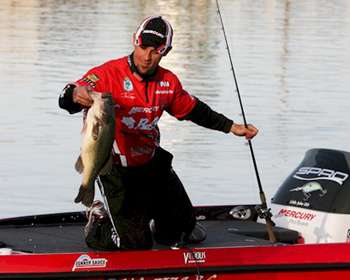
It's safe to say that it's no longer a secret that swimbaits are a coast-to-coast bass catching phenomenon. This past March, Byron Velvick used a 7-inch swimbait to claim his first Elite Series victory on California's Clear Lake.
Just three weeks later and 2,700 miles away on Virginia's Smith Mountain Lake, Skeet Reese used a 6-inch swimbait to amass the majority of his tournament winning weight.
For Crews, the biggest factor in reaching for a small swimbait is water clarity. "The swimbait is a visual bait, so I like at least 2 to 3 feet of water clarity," he explains. "Anything less, and there are other baits that are probably going to be more effective." When throwing a small swimbait, Crews opts for a hard plastic Spro BBZ1 Shad, which is a 4-inch jointed swimbait. "For me, it's a good size when I'm tournament fishing because anything will bite it," says Crews. "I've even caught bass smaller than 12 inches on the bait."
The ability for the small swimbait to garner strikes from all sizes of bass is an important aspect of its effectiveness. While the larger swimbaits in the 7- to 10-inch range drastically reduce the number of "keeper" bites, small swimbaits put both keepers and kickers in the boat. "On lakes where a 10- to 12-pound limit is a good limit, you're seeking 2- to 3-pound bass," Crews explains. "That's exactly the size of fish that will eat these small swimbaits." Crews realized the effectiveness of small swimbaits several years ago during his first outing with the BBZ1 Shad on Smith Mountain Lake. "It was right after the spawn and I just went out to experiment," he remembers. "In less than three hours, I caught over a dozen bass up to 3 pounds.
I didn't catch any giants, but they would just appear out of nowhere and eat that little swimbait." While he says that the postspawn is an ideal time to throw the smaller offering, Crews is quick to point out there are year-round applications for fishing a small swimbait. "It's definitely good anytime the fish are up shallow from prespawn through the postspawn, but it's also effective when bass are actively schooling. On a lot of lakes across the country, that happens throughout the summer and into the fall."
He also points out that anglers are experimenting with the small swimbaits during the winter, when bass are keying on larger shad. When it comes to where he likes to throw the bait, Crews looks for ambush points and shallow cover, particularly docks. "When you're paralleling docks, a lot of times those fish will just come out of the woodwork and eat it," he says.
Another effective pattern is targeting shaded areas created by undercut banks or overhanging trees.
(Provided by Z3 Media)




